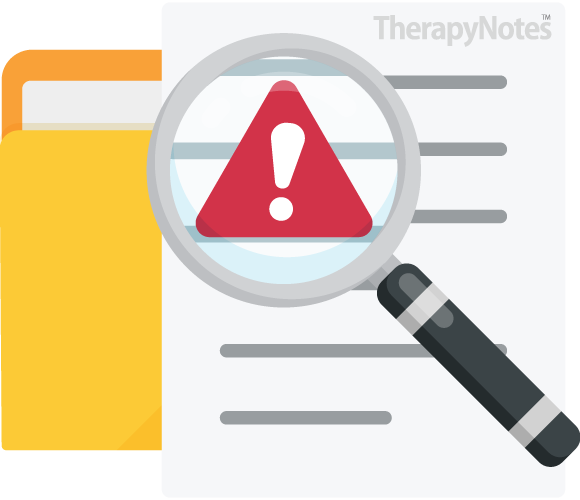Are You Unintentionally Committing Insurance Fraud?
By Dr. Ajita Robinson on June 3, 2020

It's a scary thought to wonder if you're unintentionally committing insurance fraud. But, the reality is in the data: insurance fraud happens more often than we would like to think.
Insurance fraud contributes to the rising cost of healthcare in addition to the low reimbursement rates for practitioners. To be clear, these are not the only factors that impact healthcare costs and reimbursement rates, but you can bet that insurance companies utilize this data to justify reimbursement rates and premiums. Let’s address some of the different situations that might constitute a violation of our insurance contracts.
First, a quick reminder: if you suspect that a colleague is committing insurance fraud or violating their contracts, make sure that you follow your ethical decision-making model, which may include reporting to the relevant clinical board and/or filing a fraud report with the insurance commissioner. Every state has an insurance commissioner who regulates all commercial insurance policies (health, home, life, etc.) within that specific state or district.
Billing Incorrect CPT Codes
One of the most common situations that may amount to insurance fraud typically revolves around the process of billing incorrect CPT codes. CPT codes are the service codes that you utilize to tell an insurance provider what and who was involved in a treatment, as well as the duration of the treatment and the type of service that was rendered. For example, 90837 is a 60-minute code utilized for individual psychotherapy, but the code also requires that a face-to-face component of the session lasts a minimum of 53 minutes in duration. Often, providers will schedule a 60-minute session, but the reality is the client might be late, the previous client session may have run over due to crisis assessment or other unplanned occurrence, etc. Instead of billing the lower code for the reduced time, we bill insurance under the 90837 code. However, we should have billed for perhaps a 90834 or 90832 code to accurately capture the face-to-face time spent with a client.
Reporting Improper Diagnostic Codes
Another instance where we may be unintentionally committing insurance fraud is in the diagnostic process. I frequently hear that clinicians provide clients with an adjustment disorder diagnosis when clients may not meet the medical necessity required to render these services. Similarly, a clinician may want to mask or minimize the severity of a diagnostic code that they may believe has a more significant impact on the client. For example, a client might meet the criteria for PTSD, but having that diagnosis in their medical file might negatively impact their federal clearance, so the clinician downgrades the diagnosis to Adjustment Disorder.
Another instance in which this might happen is with family therapy, namely with couples. As with any covered service, insurance companies will almost always require a thorough professional diagnosis. Many clients who seek family therapy meet the criteria for a Z code, but it's rare that insurance plans pay for Z codes. In fact, some may not even cover family therapy at all. With this in mind, many clinicians might be tempted to impose a diagnosis on one member of the family so that services are covered. For family or couples’ therapy to be covered, the diagnosis and symptoms experienced by the identified client must impact the dynamics and functioning of the family. In addition, the diagnosis must be shown to be beneficial to the identified client’s alleviation of symptoms to warrant the participation of other family members within the therapy session. There's also much debate about whether couples’ therapy is family therapy and whether insurance companies cover it. It’s always best to verify benefits and eligibility of each patient’s policy and document the information given.
Aligned with misdiagnosing, under-diagnosing, and reporting inaccurate diagnostic codes is the practice of not appropriately assessing client symptomology or utilizing standardized assessment instruments to justify the diagnosis. For example, the provider may diagnosis a client with Major Depressive Disorder, but the intake documentation lacks any standardized and clinical measurement that captures the client’s symptoms, frequency, and duration necessary to meet the required criteria for the diagnosis. Poor documentation leads to a lack of sufficient data to support medical necessity.
Balance Billing
Balance billing is a practice that providers may engage in that violates their insurance contract if they are in-network. This occurs when a provider bills the client for the balance between the provider's full fee and their contracted rate. When the provider became in-network, they agreed to a reduced fee and agreed to not charge the client above the negotiated rate. This situation can happen accidentally because, for instance, the provider might believe that if a client has a deductible, that client is responsible for 100% of the cost of services until the deductible is met. However, this is only partially true. A client with a deductible is responsible for the cost of services, but that cost is relative to the contracted rate and not the provider’s full fee.
Billing as Supervisor or Incident-to Billing
"Billing as supervisor" or "incident-to billing" refers to when a supervisor, usually a fully licensed clinician, bills for services that were provided by either a clinician who's not credentialed or who isn't eligible for credentialing. Now, let's be clear: this could be insurance fraud if the insurance panel does not allow billing as supervisor as a valid form of claims submission. This practice is most commonly accepted in agencies, facilities, and hospitals. It is rare that it is allowed in private practice, although there are a few exceptions that seem to be both state- and plan-specific. These exceptions are documented in the contract and provider manual.
Sharing Reimbursement Rates
Commercial insurance plan contracts expressly prohibit providers from sharing their actual reimbursement rates with other providers. The exception to this general rule of thumb lies with managed care providers such as Medicare, Medicaid, and TRICARE because, typically, their rates are publicly available. These antitrust laws are set forth by the federal government and are designed to prevent corporations from price gouging consumers.
Other Risky Situations
These are also things that aren’t fraud but may increase the likelihood that a provider may not pass an audit and may be subject to recoupment.
One area that may land you in hot water is clinical documentation. Clinicians have varying expectations for documentation that range from "if it’s not documented, it didn’t happen" to "document like it will be read in court." However, inaccurate documentation, untimely documentation, or delayed documentation as well as documentation that doesn't meet medical necessity can create ethical and legal issues for clinicians. Gaps in documentation can led to recoupment.
Another area that’s generally a no-no for clinicians is billing Medicaid clients or accepting Medicaid clients when you are not an in-network provider. Federal regulations require that all providers, whether they're in-network or out-of-network, engage in a principle of "do no harm" and refer those clients back to in-network providers or agree to provide pro bono counseling services. There are a few states that allow Medicaid clients to seek private pay services, but they are the exception, not the norm. Accepting Medicaid clients for private pay services in most states jeopardizes the client's benefit eligibility. As a provider, you should be knowledgeable about the requirements and restrictions in your state.
Finally, to collect the copay or not to collect the copay... Clinicians often don't perceive the practice of waiving or attempting to collect copay as insurance fraud or a contract violation. However, routinely waiving or not collecting the copay violates the terms that providers agreed to when joining the insurance panel. There are a few ways that we can assist clients without violating our contracts, such as by contacting the insurance company to see if they have an hardship programs or checking if the client has EAP benefits that might apply to our sessions.
We could continue this conversation indefinitely; in fact, we talk about it all the time in the Mastering Insurance for Mental Health Professionals Facebook group, so feel free to join us there! I hope this information was helpful in keeping you compliant and knowledgeable about the insurance process.
* The content of this post is intended to serve as general advice and information. It is not to be taken as legal advice and may not account for all rules and regulations in every jurisdiction. For legal advice, please contact an attorney.
About Dr. Ajita Robinson
Get more content like this, delivered right to your inbox. Subscribe to our newsletter.
More Content You'll Enjoy

Medicare Telehealth Update: New In-Person Visit Rules Effective January 2026

Understanding Medicare's Inclusion of MFTs and MHCs: An Informative Guide for Therapists
